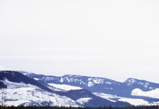
Nowhere is that more evident than in the way Canadian logging was managed. Like much of the Western U.S., the land in Western Canada is mostly controlled by the Canadian government; it's referred to as "Crown Land." It's leased out in huge blocks to logging companies, who then clear-cut the land, no matter how steep and erosion-prone the land might be.
In principle this isn't that different from the way the U.S. manages National Forest land, but there are huge differences in practice. Firstly, slipshod though U.S. forest management may sometimes be, the U.S. does require logging companies to re-seed the land they log. In addition, the land has to be re-seeded by hand (the cheapest way to re-seed is to use helicopters, but this results in a stunted, unhealthy forest for 80 years. In Canada, at the time I was there, it wasn't clear the land was required to the re-seeded at all (I certainly saw blocks that had been cut for several years without visible new growth).
There were no controls on the steepness of the land that was leased for clear-cutting in Canada. As these pictures of a scarily steep clear-cut block along Duffey Lake Road between Pemberton and Lilloet show, some of the blocks that are clear-cut are so steep they're subject to insane erosion for the next several years -- which of course fills the streams with silt as a result.
In much of the Western U.S., the logging companies have at least learned the P.R. trick of not cutting the trees immediately next to the road. No such luck in Canada, they happily cut right up to the road.
These pictures were taken mid-winter, so they don't show the true horror of what these clear-cut blocks look like. In early spring, I went hiking on a trail just south of Whistler that passed through a block which had been clear-cut the previous summer. The only way to describe it is to say that it looked like the aftermath of a "shock and awe" bombing war. The ground was torn up beyond belief, with house-sized pits where a particularly big (read: valuable) tree had once been housed, it was littered with debris (wood shards and rocks), and it looked like nothing would grow there for years. In fact, that might be true.


